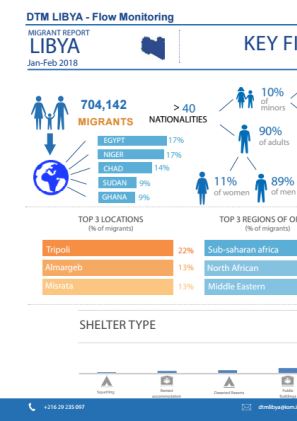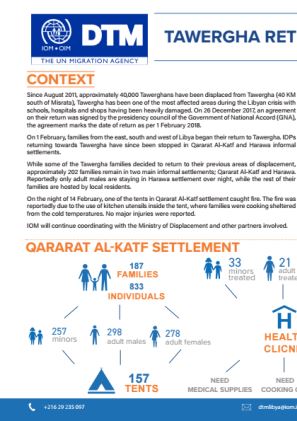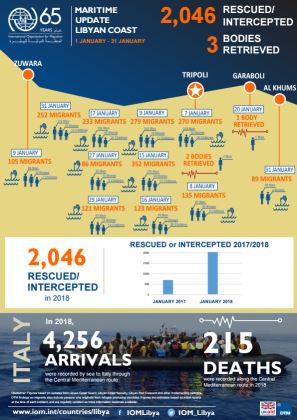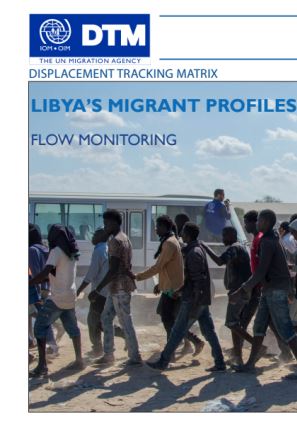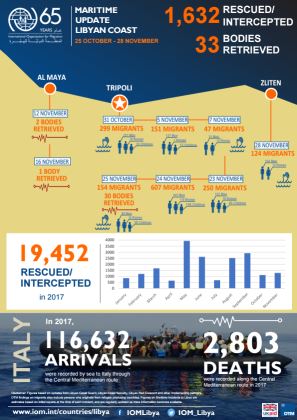-
Countries
-
Data and Analysis
-
Special Focus
-
Crisis Responses
Libya
Sobre Libya
Libya is a geographically vast country with several regions that are difficult to access. In order to understand the full scope of humanitarian assistance that is needed throughout the country, IOM established the Displacement Tracking Matrix (DTM) programme in 2016 in order to provide a common operating picture concerning the movement of populations in Libya, allowing humanitarian actors to provide timely assistance to those in need. Following the escalation of conflict and insecurity in 2014, the security situation has remained volatile since with fluctuations in the intensity of localized clashes. Congruently, conflict has caused new displacements, often in areas ill-equipped to accommodate large population movements while also negatively impacting the large migrant population residing and transiting through Libya. More recently, the capital Tripoli was heavily affected by displacement waves in September 2018 and April 2019.
DTM’s mobility tracking and flow monitoring activities identified many migrants in-country to be in need of various forms of assistance. Libya’s geographic location, resources and work opportunities has made it both a country of destination and transit for migrants for many years. Despite the deterioration of the security situation since 2011 migrants continue coming to and transiting through Libya, the majority from Sub-Saharan and North African countries.
In this complex operating environment, DTM Libya has been providing a common operating picture concerning the movement of populations in Libya since 2016, allowing humanitarian actors to provide timely assistance to those in need. Through its mobility tracking, flow monitoring and needs assessment activities, DTM Libya has established itself as data hub for quantitative data on migratory flows to and within Libya, migrant presence in Libya disaggregated by nationality and area, as well as humanitarian needs of migrants, internally displaced population and returnees. All activities are implemented through periodical bi-monthly data collection cycles, allowing trend analysis over time to provide evidence-base for both policy-level discussions and to guide humanitarian action.
In order to facilitate humanitarian interventions, DTM works closely with IOM’s other programmes through referring identified populations in need of assistance at flow monitoring points to IOM’s Direct Assistance, Health, Voluntary Humanitarian Return (VHR), Protection and Migrant Rapid Response Mechanism (MRRM) programmes. Furthermore, DTM Libya supports other humanitarian partners through providing emergency tracking updates in case of sudden population movements as well as facilitating humanitarian assessments for the Rapid Response Mechanism (RRM) jointly implemented by IOM, UNICEF, WFP and UNFPA.
For more information on IOM's activities in Libya, please visit the IOM Libya country office website.
Contacto
DTM Libya
DTMLibya@iom.int
Current Donors
- EUTF
Para obtener resultados de búsqueda más avanzados, vaya a la Página de búsqueda avanzada de informes
Libya — Migrant Report 17 (January — February 2018)
In Round 17 DTM Libya’s Mobility Tracking identified 704,142 migrants in 99 baladiyas and 5551 muhallas. 88% of identified migrants were men, while 12% were women.
Migrant Report Key Findings 17 (January — February 2018)
In Round 17 DTM Libya’s Mobility Tracking identified 704,142 migrants in 99 baladiyas and 5551 muhallas. 88% of identified migrants were men, while 12% were women.
Libya — Tawergha Return Weekly Update 1 (16 February 2018)
Since August 2011, approximately 40,000 IDPs have been displaced from Tawergha. On the 1st of February, IDP households began returning to Tawergha from across the country.
Libya — Misrata Road Accident Flash Update (14 February 2018)
On February 14 at 3:00 AM, a large truck used by smugglers to transport migrants from the As Saddadah (60 km south-east of Bani Waleed) to Tarhuna, was involved in a car accident, causing the death of 19 migrants and injuring 49 more migrants.
Libya — Maritime Update Libyan Coast (1—31 January 2018)
Between 1 January and 31 January 2018, 2,046 individuals were rescued or intercepted and three bodies was retrieved.
Libya — Displacement Event Tracking Report (8—20 January 2018)
In Tripoli, On 15th of January, heavy attacks were reported in Mitiga International Airport. In Benghazi, On 8th of January, In Thawra Echaabia muhalla 400 returnee families were reported as residing in schools. The main needs have been reported as shelter and medical assistance.
Libya — IDP and Returnee Report 16 (November — December 2017)
In November and December 2017 DTM Libya interviewed 1,426 key informants across 100 Baladiyas and 657 Muhallas. A total of 180,937 IDPs were identified.
Libya — Baladiya Data Generator Round 16 (December 2017)
This is an interactive profile generator that displays snapshots of each of Libya’s 100 baladiyas gathered through DTM Libya’s Mobility Tracking assessments. Basic multi-sectorial data from the baladiya is presented in addition to data on IDPs, returnees and and migrants in the baladiya.
Libya — Migrant Profiles 1 (December 2017)
This report provides key insights into specific nationalities present across Libya.
Jan 12 2018
Libya — Migrant Profiles 1 (December 2017)
Migrant Report Key Findings 16 (December 2017)
In Round 16 DTM Libya’s Mobility Tracking identified 621,706 migrants in 99 baladiyas and 544 muhallas. 89% of identified migrants were men, while 11% were women.
Jan 12 2018
Migrant Report Key Findings 16 (December 2017)
Libya — Migrant Report 16 (December 2017)
In Round 16 DTM Libya’s Mobility Tracking identified 621,706 migrants in 99 baladiyas and 544 muhallas. 89% of identified migrants were men, while 11% were women.
Jan 12 2018
Libya — Migrant Report 16 (December 2017)
Libya — IDP and Returnee Key Findings Report 16 (November — December 2017)
In November and December 2017 DTM Libya interviewed 1,426 key informants across 100 Baladiyas and 657 Muhallas. A total of 180,937 IDPs were identified.
Libya — Maritime Update Libyan Coast (29 November — 29 December 2017)
Between 29 November and 29 December 2017, 883 individuals were rescued or intercepted and one body was retrieved. In total, 20,335 individuals were rescued or intercepted in 2017 and 118,928 arrivals by sea were recorded to Italy through the Central Mediterranean route.
Libya — Displacement Event Tracking Report (3 — 20 December 2017)
On 3 December, DTM observed an increase in migrants entering Libya via Ghadamis, with the main nationalities being Bigerian, Malian, Senegalese and Nigerien. On the following day, landmines in Benghazi caused ten deaths.
Libya — Migrant Report 15 (October — November 2017)
In Round 15 DTM Libya’s Mobility Tracking identified 432,574 migrants across all 22 mantikas (regions) in Libya. Migrants were identified in 99 baladiyas and 531 muhallas. The three main regions where migrants were recorded as present were Tripoli (19%), Misrata (16%) and Almargeb (11%).
Migrant Report Key Findings 15 (October — November 2017)
In Round 15 DTM Libya’s Mobility Tracking identified 432,574 migrants across all 22 mantikas (regions) in Libya. Migrants were identified in 99 baladiyas and 531 muhallas. The three main regions where migrants were recorded as present were Tripoli (19%), Misrata (16%) and Almargeb (11%).
Libya — IDP and Returnee Report 15 (October — November 2017)
In October and November 2017 DTM Libya interviewed 1,366 key informants across 100 Baladiyas and 657 Muhallas. A total of 192,762 IDPs were identified. The threat of violence from conflict and the presence of armed groups was the main driver of displacement for 93% of the displaced population.
Libya — IDP and Returnee Key Findings Report 15 (October — November 2017)
In October and November 2017 DTM Libya interviewed 1,366 key informants across 100 Baladiyas and 657 Muhallas. A total of 192,762 IDPs were identified. The threat of violence from conflict and the presence of armed groups was the main driver of displacement for 93% of the displaced population.
Libya — Maritime Incidents Update (25 October — 28 November)
Between 25 October and 28 November, 1,632 individuals were rescued or intercepted and 33 bodies were retrieved. In total, 19,452 individuals were rescued or intercepted in 2017 and 116,632 arrivals by sea were receorded to Italy through the Central Mediterranean route.
Libya — Baladiya Data Generator Round 15
This is an interactive profile generator that displays snapshots of each of Libya’s 100 baladiyas gathered through DTM Libya’s Mobility Tracking assessments. Basic multisectorial data on the baladiya is presented in addition to data on IDPs, returnees and and migrants in the baladiya.
Nov 30 2017
Libya — Baladiya Data Generator Round 15
Libya — Displacement Event Tracking Report (1—21 November 2017)
On 7 November 2017, 400 families returned to Sabratha. On the same day, clasehes started in Al Maya, Muhallah Maamoura and are ongoing. On 2 November 2017, 500 families were disaplced from AlAzizyah to different muhallas within the same baladiya.
Libya — IDP and Returnee Key Findings Report 8 (January — February 2017)
During Round 8, DTM Libya identified 294,436 IDPs across 661 muhallas and 100 baladiyas. The main driver of displacement was the threat of general conflict and armed group presence (91%).
Libya — Migrant Report 14 (September — October 2017)
In Round 14 DTM Libya’s Mobility Tracking identified 423,394 migrants across all 22 mantikas (regions) in Libya. Migrants were identified in 99 baladiyas and 525 muhallas. The three main regions where migrants were recorded as present were Tripoli (18%), Misrata (17%) and Almargeb (11%).
Migrant Report Key Findings 14 (September — October 2017)
In Round 14 DTM Libya’s Mobility Tracking identified 423,394 migrants across all 22 mantikas (regions) in Libya. Migrants were identified in 99 baladiyas and 525 muhallas. The three main regions where migrants were recorded as present were Tripoli (18%), Misrata (17%) and Almargeb (11%).
Pagination
Para obtener resultados de búsqueda más avanzados, vaya a la Página de búsqueda avanzada de conjuntos de datos
Pagination
- First page
- Previous page
- 1
- 2
- 3
- 4
- 5



